Elastic fiber dyeing, finishing and finishing
Song Xinyuan (Donghua University, Shanghai 201620)
Abstract: This paper systematically introduces the structure and elasticity of various elastic fibers, including elastic yarn, spandex, polyether ester elastic fiber, polyolefin elastic fiber, hard elastic fiber, PTT and PBT fiber, and composite polyester elastic fiber. The relationship between structure and elasticity. Focusing on the elasticity of these fibers, the paper analyzes and introduces the dyeing and finishing characteristics of elastic fiber-containing textiles, especially pointing out that such textiles are prone to "creep" and "stress relaxation" during dyeing and finishing. And the "fatigue" phenomenon (deformation and recovery is different from conventional textiles), the temperature, tension and time during dyeing and finishing should be reasonably controlled. The importance of the relaxation treatment is also demonstrated. Finally, the main textiles containing elastic fibers are briefly introduced. Dyeing and finishing process, additives and precautions.
Key words: elastic fiber textile; elasticity; dyeing and finishing; auxiliaries CLC number: TQ340.47 Document code: AArticle ID:1004-0439(2011)03-0001-014
Synthetic fiber has been developed for seven or eight decades. It was originally used for clothing. There are only a few commonly used fibers, such as nylon and polyester. Since 1960, with the improvement of synthetic fiber performance, the variety has been expanding. Special fibers, microfibers, elastic fibers and industrial high-strength fibers have developed rapidly. Among them, elastic fibers are not only used in various high-performance garments, but also in decorative textiles. Currently, synthetic fibers are mainly sustainable and recyclable. The development of biodegradability and nano-functionality. The same is true for elastic fibers. A number of new elastic fibers have emerged, mainly through the following ways: (1) changing the basic material, ie the molecular structure of the polymer; 2) changing the supramolecular or microstructure of the polymer; (3) blending or mixing different polymers into appropriate additives; (4) changing the fiber morphology, such as fiber thickness, cross-sectional shape, degree of curling, etc.; The filament component is compounded or plied to form a double or multi-component composite fiber; (6) the surface of the fiber is modified or the surface structure is changed; (7) the filament is twisted or compounded to change the number and shape of the yarn. The above ways can be changed The properties of fiber materials (including elastic function). The most important way is to change the basic composition of the fiber (ie, the molecular structure of the polymer). In recent years, many new polymers have been developed and a large number of elastic fibers with different molecular structures have been spun. Secondly, different polymers are blended or compounded. Since the fibers contain a variety of polymers, their properties, including elasticity, will change. By changing the mixing and mixing modes and changing the mixing ratio of the components, the properties can be further changed. For example, the two-component composite fiber can be greatly improved in elasticity after being crimped; in addition, changing the cross-sectional shape of the fiber or modifying the surface or changing the surface structure can also change its properties, including improving the elasticity of the textile; Multifilament ply, changing the number of strands, or twisting the yarn, etc., can improve the elasticity of the textile.
At present, textiles are mainly developed in the direction of toughness, safety, durability, fineness, environmental protection, comfort, beauty and easy care. Safety, environmental protection and comfort are especially important, and these functions are closely related to the elasticity of fibers. The elasticity of textiles is a kind of Important taking performance, it refers to the ability of materials to resist and recover deformation. Elastic fiber refers to fibers or tows with high elongation and high resilience. Different countries or regions have different definitions. According to the elasticity of the American Society for Testing Materials The definition of the body refers to the material that is repeatedly stretched to at least 2 times the original length at room temperature, and can quickly return to the original length after releasing the tensile force. However, for the polyurethane elastic fiber, the tensile strength can be released after stretching the original length by 3 times. Quickly restore the original long fiber. In recent years, textiles have become more and more elastic. In order to meet the needs, many new elastic fibers and textiles have been developed. These new elastic fiber textiles have high processing requirements, especially for dyeing and finishing. The processing is very difficult. To this end, this paper first introduces the structure and elasticity of elastic fibers, and then discusses the dyeing and finishing of elastic fiber textiles.
1. The category of elastic fibers or filaments and the elasticity of elastic textiles are mainly determined by their structure, including the chemical structure of the fibers, the supramolecular or microstructure of the fibers, the morphology of the fibers or yarns, and the texture of the textiles. Controlling the above structure can improve or improve the elasticity of textiles.
For ordinary textiles, due to the general structure of fibers, yarns and textiles, although it has certain elasticity, the elasticity is not high. For elastic textiles, elastic fibers or yarns are selected and woven into certain Organizational structure, so the elasticity is good.
The elasticity of a fiber or yarn is mainly determined by the polymer molecular structure of the fiber. That is, the elastic fiber or yarn currently on the market is mainly composed of an elastic polymer. These elastic polymers have a special molecular chain structure and a supramolecular structure. High elastic deformation occurs after stress, which is a reversible deformation characteristic of these high polymer materials. When the temperature is higher than the glass transition temperature, the polymer segment in the amorphous region can move freely, and the entire polymer chain In the high-elastic state, which still cannot move, when the external force is applied, the movement of the chain may cause the macromolecular chain to partially curl or stretch, and the deformation can reach 100%~1 000%. The material becomes soft and elastic; after the external force is removed It will gradually return to its original state as time goes by, some of the deformation will recover quickly, and some deformations can only recover slowly. The polymer suitable for making elastic fibers is usually a block copolymer, and the macromolecules are long segments with good flexibility. (soft segment) and rigid short segment (hard segment) alternately. Soft segment makes fiber easy to deform and stretch, while hard segment is stronger due to mutual interaction, and some even establish covalent cross Bonded to give fiber strength Degree and resilience. At present, the high polymer mainly has block polyurethane and other synthetic copolymers. The elastic fabric mainly relies on the elastic fibers mixed in the warp and weft to improve the elasticity.
Elastomeric textiles can also impart good elasticity by changing the supramolecular or microstructure of the fibers. Other textile fibers or yarns have good morphological structure or structure, which makes them have good elasticity. The yarns with strong twist impart a good resilience. Different elastic fabrics can be selected according to their use, respectively, and the yarn or fabric structure can be used to improve the elasticity. In short, the types of elastic fibers or filaments can be classified into the following. Several categories.
1.1 twisted textured yarn or elastic filament twisted textured yarn commonly known as elastic yarn, usually pre-oriented silk or full-stretched silk, etc., through the twisting deformation or twisting-setting-untwisting process, processing into small springs Curled filaments. They have a high degree of elastic stretch and fast recovery. The elasticity of the filaments is not strong. The elasticity of the filaments comes from the elasticity of the spring-shaped strands after shaping, rather than the elasticity of the molecular chains. After the shape disappears, the elasticity of the thread also disappears, because the elasticity of the polymer is not high. The textile made of the elastic yarn, especially the dyeing and finishing of the knitted fabric and the non-elastic textile made of the same polymer. Basically similar, it should be noted that during the dyeing and finishing process, the spring shape of the wire should not be lost or loosened. Therefore, the tension should be small when processing at high temperature, and the time cannot be long. Because the elasticity of the textile becomes loose or disappears as the spring shape becomes loose. It is greatly smaller.
1.2 Polyurethane elastic fiber Polyurethane elastic fiber [1] is the most important type of elastic fiber commonly known as spandex, which is made of elastomer or elastic polymer. The so-called elastomer is easy to deform under the application of external force, but when external force After removal, the original polymer can be restored. The most typical example is vulcanized rubber. Their molecular chains are soft, the interaction force is small, and they are easy to move and deform. They are amorphous polymers. After the mesh structure, the deformation recovery ability is greatly improved, so the elasticity is very good. In the past, many high-elastic textiles were woven into a part of the rubber yarn to improve the elasticity. Because of the many disadvantages of the rubber yarn, the elastic textile is becoming less and less.
The elastic fibers made of elastomers mainly include polyurethanes, polyether esters, polyolefins, polycarbonates, etc. Their "soft" and "hard" segments have different chemical compositions and structures, so the elastic size, dyeing and finishing Processing performance will be different.
Polyurethane elastic fiber has been mass-produced and applied, and it is developing rapidly. It is a kind of high-elastic fiber widely used in various textiles. Its elasticity originates from its molecular structure, firstly the embedding of "soft" and "hard" segments. Segment copolymer network structure, also known as "segment" network structure. However, this fiber has different spinning processes depending on the block copolymer. After forming different "segment" network structures, the elasticity and dyeing and finishing properties are also Different. The "segment" structure of the copolymer is obtained by the stepwise polyaddition of diisocyanate. The low molecular diisocyanate reacts with the low molecular dihydroxy compound to produce shorter "hard" segments. Because of their various polarities The groups (especially urea groups) can form more hydrogen bonds with each other, and are easy to crystallize and crosslink between molecules. Under the action of lower stress, the segments are basically not deformed and can be prevented. Slip between the macromolecules of the fiber, and provides a node for the rebound of the "soft" segment after a large elongation, and also gives the fiber a certain degree of strength, modulus and wear resistance. "The chain segment is made up of long chain dihydroxy compounds (macromolecule II) The composition of the alcohol has a relative molecular mass of 1,500 to 3,000, a melting point of <50 ° C, a segment length of about 15 to 30 nm, about 10 times the length of the "hard" segment, and a low glass transition temperature Tg ( It is -50~-70 °C). The long-chain diol can be polyester, polyether, polycarbonate, polyacetone and their composites. They are difficult to crystallize and are in a high elastic state at normal temperature. Large deformation can occur under small stress, making the polyurethane fiber easy to stretch. According to the "soft" segment containing ether or ester, polyurethane elastic fiber is divided into two major categories, polyether and polyester. Fibers are not only different in elasticity, but also in dyeing and finishing properties, chemical stability and aging resistance. In general, polyethers are softer, more deformed by force, and fiber network structure after stretching. It is very obvious that when the "soft" segment of the polyester type is stretched by 200%, the molecular chain is continuously oriented along the fiber axis, but no crystallization occurs; the polyether type not only is oriented but also crystallizes because of the polyether molecule. The chains are more easily close to each other and arranged in a regular manner. From the perspective of dyeing and finishing, polyester-type polyurethane fibers are resistant to oxidation and heat. Preferably, the disperse dye adsorption is also strong; polyether detergent resistance and fungus resistance so better processing conditions of both the product and the applicable different long chain molecular structure of polyurethane as follows:. 
The molecular soft segment of polyurethane fiber is composed of macromolecular diol compound segments, their molecular interaction is weak, the molecular segment is easy to move, and the soft segment quality accounts for 65%~90% of the total polyurethane fiber quality. Elongation or shrinkage and curling. When the fiber is stretched, it tends to be fine and elongated, and the order is improved. The order of the soft segments is different after stretching. It has been pointed out that the soft segment inside the polyurethane filament is not stretched. It is amorphous and non-oriented, but after 200% tensile elongation, the fibers composed of polyester diol are oriented along the molecular chain of the fiber axis, but no crystals appear, and the fiber along the polyether diol The fiber axis is not only oriented, but also crystallization. This is due to the different tendency of the two molecular chains to crystallize. The polyurethane hard segment is shorter and contains more polar groups, mainly urea groups and urethanes. Their molecular chains are not easy to move freely, and there is a strong molecular force between them (including the formation of hydrogen bonding), so the hard segment is directly related to the strength and heat resistance of the fiber, and is also a key component of the elastic restoring force. It and the soft segment form a "section" network structure, Fiber excellent elasticity.
At present, polyurethane elastic fibers are mainly produced by a solvent spinning process, and a large amount of solvent (for example, DMF, etc.) is required. These solvents have problems such as environmental pollution and adverse effects on human health, and therefore, the production of melt spinning production technology has been vigorously developed in recent years. The fiber produced is not as good as the traditional solvent method in terms of elastic recovery rate, hydrolysis resistance and heat resistance. However, as the spinning technology continues to mature, the product performance has gradually approached or reached the level of traditional fiber, so the melt spinning There are more and more fiber varieties. Polyurethane elastic fibers produced by different processes are not completely identical in chemical composition and supramolecular structure, and their elasticity and dyeing and finishing properties are obviously different. Attention should be paid to dyeing and finishing. In terms of the products produced, the performance of polyurethane elastomers produced by using different raw materials is also very different. For example, the fibers produced by polycaprolactone diol have good water resistance, and the heat resistance produced by polycarbonate diol is good. The polyester polyester oligomer can improve the elasticity as a crosslinking agent, and the addition of a suitable diamine compound can also improve the dyeability, etc. In order to meet market demand, Also produces a number of high moisture absorption and desorption spandex, heat setting spandex and antibacterial, abrasion resistance, chlorine, antistatic, absorbent, deodorant performance spandex, breathable, warm, etc. [2]
1.3 Polyetherester Elastic Fiber Polyetherester Elastic fiber is an elastic fiber obtained by melt spinning of polyester and polyether copolymer. It was first produced by Teijin in 1990. Polyetherester elastic fiber and polyurethane elastic fiber structure. Similarly, it also has a "segment" structure. The "soft" segment is mainly a polyether segment. It has good flexibility and a long chain, so it is easy to elongate and deform. The "hard" segment is a polyester segment. It is relatively stiff, easy to crystallize, and has a short chain. When the fiber is deformed by force, it acts as a joint, giving elastic recovery properties and determining the strength and heat resistance of the fiber. It is not available in both polyether and polyester segments. The ability to form covalent bonds is also difficult to form hydrogen bonds. Therefore, the molecular chain network nodes are mainly crystalline units, that is, crystalline units formed by polyester segments. The "segment" structure of such elastic fibers is schematically as follows: 
Wherein R1 is a polyether alkyl group, the polyether chain is long, and the flexibility is good, and is a soft segment; R2 is an alkyl or aryl group of a dibasic acid, and the segment is relatively rigid, short, and easy to crystallize. , is a hard segment; R3 is an alkyl group of a diol, the diol segment is also short, easy to crystallize, and the ester segment acts as a hard segment, and is relatively compliant only when the R3 chain is long. More elastic fibers are PET as a hard segment, PEO is a soft segment, which can be expressed as PET/PEO. It is divided into strong, medium and high strength elastic fibers. As can be seen from Table 1, various polyether esters are elastic. The fiber not only has high strength but also good elasticity. When the elongation is 50%, the elasticity of the medium-strength elastic fiber is equivalent to that of spandex. Their melting point is also high, and it is blended with PET fiber, which can be dyed at 120~130 °C. Polyester fiber can also be processed into elastic textiles. In addition, they are excellent in light resistance, chlorine bleaching resistance, acid and alkali resistance, etc., and are better than ordinary spandex. Because of good acid and alkali resistance, they are woven with polyester. The fabric can also be alkali-reduced to improve the drape of the fabric, so the elastic fiber can be used in silk garments. The fiber raw material is cheap, easy to produce and process, and is a kind of promising fiber. At present, Rexe of Japan Teijin Co., Ltd. has been commercialized and has received market attention. 
1.4 Polyolefin elastic fiber Polyolefin elastic fiber is an elastic fiber made of polyolefin copolymer, mainly obtained by copolymerization of ethylene (mass fraction ≥ 95%) with other olefins. The copolymer also has "soft" and "hard" "Structure: a "hard" segment region of a network system consisting of covalent bonds (crosslinking points) between crystals and macromolecular chains, and a "soft" segment region composed of longer flexible polyolefin chains. The chain is easy to move and belongs to an amorphous arrangement. This "soft" and "hard" segment structure gives fiber elasticity. It is represented by the Dow Chemical Company's Lastol fiber, also known as Dow XLA fiber, which is officially named Elastolefin fiber. The microscopic network structure of this fiber and the cross-sectional shape of the 155.6 dtex fiber are shown in Figures 1 and 2. [3] 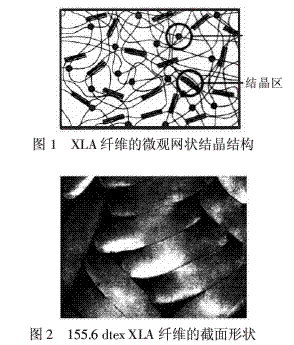
The polyolefin elastic fiber molecules do not contain polar groups, and the linkage between the molecular chains depends on crystals and covalent bonds. Due to the high proportion of non-polar polyolefin chains, the molecular chain of the amorphous region is longer and easy to move freely. The average crystallinity is about 14%. The crystallinity, crosslink density and the compliant chain length determine the elasticity of the fiber. They have large deformation under low stress and soft elasticity.
Unlike the above two kinds of thermoplastic elastic fibers, polyolefin elastic fibers have a crystal node and a covalent bond crosslinking point, so as the temperature rises to about 80 ° C, even if the crystal melts, the covalent bond still exists until 220 ° C The fiber can still maintain its shape. When the temperature is lowered, the crystal network is re-formed, and the fiber can quickly restore its strength and elasticity. The strength and heat resistance of the elastic fiber are determined not only by the degree of crystallinity, but also by covalent bonds. The network structure is closely related, that is, the length of the polyolefin chain and the distribution of the covalent bond, the density has an effect on the strength and heat resistance, but the distribution and density of the covalent bond often play a leading role. As can be seen from Figure 3, At 25 °C, the two kinds of elastic fibers are intact in shape and smooth in surface; at 220 °C, the spandex has broken and broken into pieces, and the XLA fiber remains in its original shape without decomposition and fracture. Although its physical and mechanical properties have occurred. A great change (because the crystal has melted at around 80 ° C), but because the covalent bond crosslinked network structure has not been destroyed, the fiber morphology can still be maintained intact. The melting and recrystallization of the crystal is reversible, when the temperature drop When the crystal network is re-established at room temperature, the physical and mechanical properties of the fiber can be basically restored. Therefore, the elastic fiber is suitable for the heat-resistant textile product, and is not easily damaged during the dyeing and finishing process. The dimensional stability is good and the elongation is not easy. Deformation and wrinkling. Also based on this microstructure, textiles do not require preheating and shaping, and other thermoplastic fiber textiles require preheating to improve their processing stability. So this fiber is very suitable for silk, wool, Acrylic, nylon and other high temperature sensitive fibers are blended or interwoven, and are of course also suitable for blending or interlacing with fibers that require heat setting. 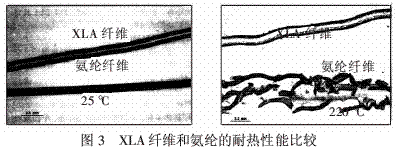
XLA elastic fiber has obvious difference in elasticity and other elastic fibers due to its special microstructure. As can be seen from Fig. 4, XLA fiber has greater elongation and restoring force under lower stress, indicating that it has softer elasticity. , that is, the stress required for stretching is small, the recovery is very good, and the finished textile is more comfortable and comfortable when worn. Of course, when the fiber textile is dyed and finished, the tension should be small, and it is not suitable for strong pulling, so as to avoid excessive deformation. 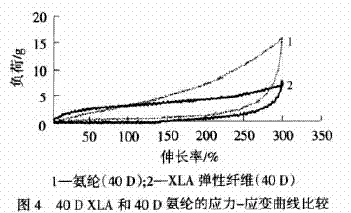
XLA fiber is a hydrophobic fiber, the molecule does not contain polar groups, so its chemical stability is very good, not only resistant to strong acid and alkali, but also resistant to various oxidants. Spandex has poor chlorine bleaching resistance, and XLA fiber resistance Chlorine bleaching is very good. However, since XLA fiber is a kind of polyolefin fiber, it has poor resistance to organic solvents, and many solvents have strong swelling effect on it. In addition, the light resistance of XLA fiber is slightly higher than that of commonly used fiber. Poor, but better than spandex, which is related to its existence of a covalent bond cross-linking point.
XLA fiber itself does not have suitable dyeing dyes, but it is suitable for blending or interlacing with other fibers into various elastic textiles. Due to heat resistance, chemical resistance, and special mechanical properties, elongation recovery performance is good, and photodegradation resistance is also better. Good, so it has been developed for a variety of blended or interwoven textiles, including textiles blended or interwoven with wool, cotton, etc., especially swimwear, underwear, anti-wrinkle elastic fabrics, such as elastic denim, non-iron business wear and leisure sports Shirts, etc. These garments have better drapability and feel than spandex textiles, and because of the fibers, the garments remain elastic after repeated dry cleaning. In addition, the fibers do not release volatile organic compounds. Without heavy metals, the finished garments can be recycled, also known as "environmentally friendly" elastic fibers.
It has recently been reported that Dow Chemical will withdraw from the polyolefin-based elastic fiber “Dow XLA†(it is expected to complete the retreat after 6-18 months). From the perspective of developing elastic fiber textiles, it is hoped that new similar fibers will appear. Or develop alternative products of this type of fiber to produce elastic fiber textiles with excellent performance.
1.5 Hard Elastic Fibers The above elastic fibers are all soft elastic fibers, which undergo large deformation and recovery under lower stress. For example, polyurethane elastic fibers are stretched, and the long chain of the crimped metal is stretched when the tensile force is released. After that, the long molecular chain can be restored to its previous state. From a thermodynamic point of view, the elasticity comes from the degree of freedom (or chaos) of the molecular chain, that is, the change in the entropy of the system. Therefore, the crystallinity of the above fibers is very low (because it is high) The degree of freedom or entropy of the molecular chain of the crystallinity fiber is very low, and the elasticity of the fiber is not high. However, some fibers obtained under special processing conditions, such as polypropylene (PP), polyethylene (PE), etc., They are not easily deformed under low stress (because they have a higher modulus), but they also have better elasticity under higher stress, especially at lower temperatures, so these fibers are called hard elastic fibers.
The deformation and recovery of the hard elastic fiber are significantly different from those of the foregoing elastic fiber. For example, when the hard elastic PP fiber is stretched and then subjected to the second stretching, the modulus and strength are greatly reduced. However, if the stress is removed, a section is placed. After the time, or raising the temperature to make it relax sufficiently and then performing the second stretching, the deformation recovery is substantially close to the first curve. This is because the soft elastic fiber not only undergoes the aforementioned soft elasticity when stretched and recovered. The long segment of the crimped molecule of the fiber is stretched and retracted, and some microporous structure changes are formed along the stretching process, and their wafer network structure also changes. Only after these structural changes are gradually repaired Return to the original stretching and recovery state, so they will be deformed and recovered under higher pressure, so it is called hard elastic fiber.
It can be seen from Fig. 5 that when the hard elastic polyvinylidene fluoride fiber is stretched, the oriented wafer is slowly separated, the amorphous molecular chain undergoes a process of crystallization transformation and plastic deformation, and two yield points appear in the deformation curve. Wafer separation and plastic deformation, that is, not only the elongation and retraction of the crimped molecular chain, but also the deformation of the amorphous region structure and the rotation and separation of the crystal region, and the enthalpy of the system also changes. The repair time is longer after stretching and deformation. Due to the special microporous structure between the wafers, the fiber has good elasticity. [4] 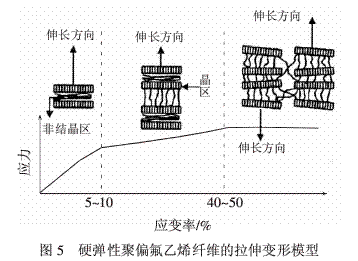
At present, hard elastic fibers are not widely used in textiles, but because of their different elastic characteristics, they can be developed for some special textiles.
1.6 PTT and PBT Elastic fiber PET fiber is one of the most important synthetic fibers. It has many excellent properties and proper elasticity. From the molecular composition, it can also be divided into two parts: hard component and soft component. as follows: 
Since the soft component chain is not long, the fiber is easy to crystallize and has elasticity. In the PTT and PBT fibers, the ethylene glycol in the PET fiber is replaced by propylene glycol and butylene glycol, respectively, and the methylene group of the soft component in the long chain of the molecule is composed of Two of them are replaced by three and four, respectively. Not only the chain length of the soft component grows, but also the softness, and the lattice structure of the fiber and the planarity of the molecular chain are also accompanied by changes, so that the deformation recovery of the molecular chain is different from that of the PET fiber. In particular, PTT fibers contain 3 methylene groups in the soft component, and there is a so-called "odd carbon effect". The odd methylene chain makes the benzene ring in the polyester unit not in the same plane as the 3 methylene units. The two carbonyl groups can only be arranged in a 120° staggered arrangement, thereby making the long molecular chains of PTT spirally arranged. The conformation of long molecular chains in PTT crystals is studied by X-ray and electron diffraction, and it is found that -O-CH2—CH2— CH2-O—the unit has the lowest energy trans-side-side-trans-conformation, and the molecular chain has a zigzag conformation (as shown in Figure 6), making the PTT long molecular chain have the same coil spring. Elasticity, not only low fiber modulus, but also good internal recovery. Because of this spiral structure, outside Under the action of the "by-side" unit, the chain rotation is easy to transform into a "trans" conformation, the molecular chain is easy to elongate, and the configuration of the molecular chain does not change during the rotation of the bond. The conformational transition is reversible. After the external force is removed, it will quickly return to its original state. 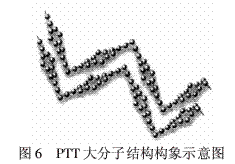
The Z-shaped conformational molecular chain of PTT fiber contains two molecular chain repeating units in the C-axis direction in the unit cell. There is only one PET and PBT fiber, so the crystal lattice size is large, incomplete, and the crystallinity is low. The conformation of the amorphous region with high content and easy deformation ".Z" shape gives high elasticity, but due to the "Z"-shaped conformation in the crystal phase, the long molecular chain cannot be conformed to change very quickly after the force, and there is no The molecular chain arrangement of the shaped region is basically non-oriented, so the conformational change does not directly produce a high elastic deformation. Therefore, it is generally believed that the good elasticity of the PTT fiber originates from the "odd carbon effect" and needs further study. However, it has Good elasticity gives the textile good morphological stability characteristics, so this fiber is also called shape memory fiber. It can be seen from Figure 7 that the PTT fiber has better elasticity than PET and PBT fiber. PBT fiber elasticity ratio PET Well, the reason is that PBT has 4 methylene groups, the chain is relatively long, and after stress, the lattice structure will be reversibly converted from α-crystal form to β-crystal form. However, it is still worse than PTT. 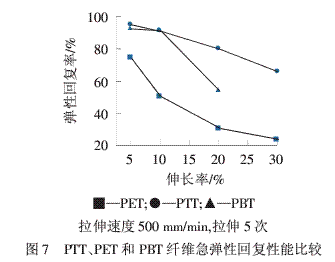
1.7 Composite polyester elastic fiber has many ways to improve fiber elasticity or develop high elastic fiber, but the main way is to synthesize new polymer molecules and make certain supramolecular structure. The new polymer molecule is the foundation, fiber The supramolecular structure is the key. Although the elasticity of PTT fiber is higher than that of ordinary synthetic fiber such as PET, it is lower than that of spandex. Although it can meet the requirements of general textiles, it can not meet the needs of high elastic products. To further improve the elasticity of this fiber, Developed a two-component composite crimped elastic fiber by conjugated spinning of two polymers with different structures and properties, the elasticity of which is based on the shrinkage or elongation difference of the two components in the fiber. PTT/PET side-by-side composite spinning, after heat treatment, due to the different shrinkage of PTT and PET, the composite fiber is spirally bent around the fiber axis to form highly crimped fibers with great elongation and elastic recovery. The current representative product is PTT/PET bicomponent fiber T-400 produced by Invista. Its longitudinal and cross-sectional shapes are shown in Figure 8. This elastic fiber has good performance. 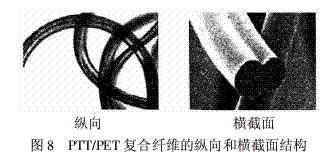
At present, a large number of elastic fibers used in the market, in addition to spandex, some new elastic fibers (such as composite polyester, polyolefin elastic fiber, etc.) are used more and more. The former such as T-400 fiber, the latter such as Dow XLA fiber. The European Commission has officially proposed to add these two types of fibers to the list of elastic fibers, and define the former to contain more than two kinds of elastic fibers composed of different linear polymers with ester groups, the latter being composed of 95% partially crosslinked ethylene hydrocarbons. An elastic fiber composed of at least one other olefin. These two fibers are referred to as Elasterell-P and Lastol in the US Textile Fiber Product Identification Act.
These elastic fibers have different compositions and different production methods. Their morphology and properties (including elasticity and dyeing and finishing properties) are different. Observing their longitudinal and cross-section, the longitudinal surface of the composite polyester elastic fiber has obvious grooves and cross-section. The cross section is "8" shape, and the fiber is fine; the longitudinal surface of the polyolefin elastic fiber is relatively smooth, the cross section is oblong, and the fiber is relatively thick; the longitudinal and cross-sectional morphology of the spandex monofilament is similar to that of the polyolefin elastic fiber. However, its shape varies greatly with the variety, and its performance is also significantly different from that of polyolefin elastic fiber. Moreover, the longitudinal direction of spandex multifilament often shows that two or more fibers are stuck together, so the cross section is dumbbell-shaped and the fiber is thicker. .
The physical and chemical properties of these kinds of elastic fibers are also different. The spandex can be dissolved in dimethylformamide or 75% sulfuric acid, while the polyolefin elastic fiber is insoluble in concentrated sulfuric acid (95%~98%), and the composite polyester elastic fiber is It can be dissolved in concentrated sulfuric acid, but insoluble in dimethylformamide or 75% sulfuric acid. Due to different chemical composition, the infrared spectra of these fibers are completely different. The composite polyester elastic fiber exhibits obvious infrared spectrum of polyester, polyolefin elasticity. The infrared spectrum of the fiber is similar to that of polyethylene, except that it also has a characteristic absorption peak of cross-linking of the vinyl group. The infrared spectrum of the spandex is significantly different from the above two kinds of fibers, and the characteristic absorption peak is a urethane group. The absorption peak. Elemental analysis also found that in the polyolefin elastic fiber, in addition to the main components of carbon and hydrogen, there are also oxygen and silicon elements, which indicates the presence of siloxane component in the fiber crosslinker, these properties can be used Identification of elastic fibers.
Because of the different chemical composition and structure, fiber supramolecular structure and morphological structure of these elastic fibers, their basic properties and dyeing and finishing properties are different. Some performance comparisons are shown in Table 2. PTT/PET composite fibers are permanently curled. It has elasticity and can be directly processed by textile without coating. Because of its low initial modulus, it is soft and smooth, and it is not easy to relax. It has good chemical stability. It is a polyester fiber with good dyeing performance and dyeing temperature. Low, easy to dye dark. 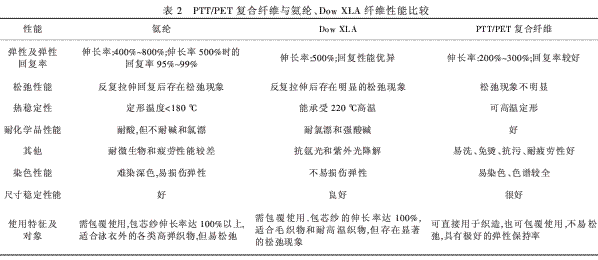
Elastic fibers have evolved from rubber elastomers in the direction of diversification and functionalization. With the elastic fiber, mechanical properties, thermal and chemical stability, dyeing and other dyeing and finishing properties, elastic fiber applications Constantly expanding. Due to the chemical composition of the elastic fiber, the molecular structure, the supramolecular and micro-structure of the fiber, the morphology and surface structure of the fiber, and the processing of twisting and compounding, the dyeing and finishing characteristics of the textile are different. Dyeing and finishing The process conditions should be formulated according to the characteristics of different elastic fibers, and the elastic fibers should not be damaged as much as possible.
2. Elastic fiber textile dyeing and finishing characteristics The dyeing and finishing properties of elastic fiber are related to the chemical and physical structure of the elastic fiber, and are related to its elastic structure and composition. How to maintain elasticity or minimize the dyeing and finishing process The damage to elasticity is the first problem to be aware of.
From the chemical composition point of view, some elastic fibers and ordinary fibers are the same or different. For example, twisted textured yarn or elastic yarn, the composition of which is mostly polyamide, and the dyeing and finishing performance of ordinary polyamide fiber is basically the same. Also like PTT, PBT and composite polyester elastic fiber (T-400 fiber), their chemical composition is polyester, chemical stability is similar, but slightly different with the chain length of the glycol. They can be dyed with disperse dyes, dyed The temperature and suitable disperse dyes vary from diol to alcohol. The difference in diols results in differences in the hydrophobicity, supramolecular structure and dyeing rate of the fibers. In addition, polyetherester elastomers contain polyesters and polyethers. Structure, chemical stability, dyeing properties and polyester fiber are close to each other. It can also be dyed with disperse dyes, but the disperse dyes and dyeing conditions used are more different from ordinary polyester fibers. Other elastic fibers, such as polyolefin and hard. Elastic fibers, whose chemical composition is polyolefin or its derivatives, lacks polar groups in the molecular composition, is a hydrophobic fiber, and has good chemical stability, but it is difficult to dye. The chemical stability of spandex is not very good. Don't be resistant to chlorine bleaching, poor light resistance and poor dyeability. There is no suitable dyeing. Although disperse dyes can be dyed, they are not dyed deeply and have poor color fastness. Some newly developed functional spandex molecules are introduced. Some special compositions, dyeing, chlorine resistance, etc. have been improved. It can be seen that due to the diversity of chemical compositions, elastic fibers have different dyeing and finishing characteristics, so attention should be paid to their chemistry during dyeing and finishing. composition.
From the perspective of physical structure, mainly supramolecular structure and morphological structure, different elastic fibers are also very different. In particular, the composition and structure of the deformation and recovery of the fiber are closely related to the dyeing and finishing properties. Or elastic yarn, its elasticity mainly comes from the shape of a coiled spring-like fiber, which is formed by twisting-setting-untwisting. Therefore, after the dyeing and finishing process is subjected to tension, especially at high temperatures, Change the shape of the curled spring to weaken its elasticity. The tension and temperature of the dyeing and finishing process should be carefully controlled, not subject to excessive tension and excessive temperature, especially repeated processing under damp heat conditions, and should maintain low tension. Or after the tension processing, the relaxation treatment for a certain period of time under no tension is beneficial to improve the elasticity.
For most elastic fibers, their elasticity mainly comes from the segmental structure of "soft" and "hard" molecular segments, but the "hard" segments of different elastic fibers are very different. Polyurethane, polyether ester, PTT The hard segments of elastic fibers such as PBT and hard elastic are stiffer or crystallized, the molecular chains are closely arranged, and a strong force is established between the molecular chains, and becomes a molecular chain network node, so the restoring force is strong, so that the fibers It has good elasticity. However, due to these forces between the molecular chains, it is easy to disassemble when subjected to high temperature or solvent, and the molecular chains move with each other to make the elasticity disappear. Therefore, the network nodes established by this structure are in high temperature or solvent. Will be destroyed, the so-called "hard" segment network nodes will disappear or the crystal will disappear, so that the fiber loses the restoring force, the elasticity is weakened.
For polyolefin elastic fibers, for example, the "hard" segment of XLA fiber is both crystalline and covalently bonded. The crystal melts as the temperature rises to about 80 °C; but the covalent bond does not break, so at 80 Above °C, it still has good elasticity and can be processed at higher temperature. Of course, when it is above 80 °C, the physical and mechanical properties of the fiber will change greatly due to the melting of the crystal, so the processing tension should be low, and it is better to be 80. When it is below °C, it will be relaxed for a certain period of time to recrystallize the molecular chain and improve the elasticity and mechanical properties.
It can be seen from the above that when the elastic fiber textile is dyed and finished, the control of processing tension and temperature is very important. Not only the maximum tension and temperature are controlled within a certain range, but also the time of tension and high temperature treatment. The longer the time, the elastic structure of the fiber The greater the damage or elastic loss, so the fiber textile dyeing and finishing process should be carried out under low tension and low temperature. It should also avoid using solvents or additives that have swelling effect on the fiber. The processing time under tension should be short, even if the tension It is not too big, and it is not suitable for tension for a long time. Because the fiber and the yarn are subjected to tension, although the deformation amount is proportional to the tension within a certain period of time, under a certain tension, the deformation amount will increase with time.å¼ åŠ›åŽ,å˜å½¢é‡ä¹Ÿä¸ä¼šç«‹å³æ¶ˆå¤±,å› ä¸ºçº¤ç»´å’Œçº±çº¿çš„å˜å½¢æœ‰æ€¥å¼¹æ€§å˜å½¢ã€ç¼“弹性å˜å½¢å’Œå¡‘性å˜å½¢.åœ¨ä¸€å®šå¼ åŠ›ä½œç”¨ä¸‹,å˜å½¢éšæ—¶é—´å»¶é•¿è€Œå¢žåŠ ,å³å‘ç”Ÿâ€œè •å˜â€çŽ°è±¡.å之,在ä¿æŒæ’定å˜å½¢æ—¶,纤维内部的应力则会éšæ—¶é—´å»¶é•¿è€Œä¸æ–下é™,å³å‘生“应力æ¾å¼›â€çŽ°è±¡.å‘ç”Ÿè •å˜å’Œåº”åŠ›æ¾ éƒ½èµ·å› äºŽçº¤ç»´çš„ç»“æž„,包括分å链结构ã€è¶…分å结构和形æ€ç»“æž„.纱线的å˜å½¢è¿˜å’Œçº±çº¿å†…纤维的相互滑移和错ä½æœ‰å…³.对弹性纤维åŠå…¶çº±çº¿æ¥è¯´,虽然产生弹性的组æˆå’Œç»“æž„ä¸åŒ,而且它们的弹性比普通纤维高,但在ä¸åŒå¼ 力下弹性水平ä¸åŒ,急弹性ã€ç¼“弹性和塑性å˜å½¢ç¨‹åº¦ç›¸äº’差别很大,è •å˜å’Œåº”力æ¾å¼›ç‰¹æ€§ä¹Ÿå„ä¸ç›¸åŒ.
æŸ“æ•´åŠ å·¥æ—¶,纺织å“çš„ç»å‘会长时间å—åˆ°è¾ƒå¤§çš„å¼ åŠ›ä½œç”¨.例如在连ç»ç²¾ç»ƒåŠ å·¥ã€æŸ“色和åŽæ•´ç†æ—¶,为了使纺织å“è¿žç»è¿è½¬,ç»å‘都è¦ä¿æŒä¸€å®šçš„å¼ åŠ›.å³ä½¿å¼ 力大å°æ’定,由于作用时间长,纺织å“çš„å½¢å˜(主è¦åæ˜ åœ¨é•¿åº¦ä¸Š)会éšæ—¶é—´å»¶é•¿è€Œä¸æ–å¢žåŠ ,å³çººç»‡å“会ä¸æ–伸长,并引起纬å‘ä¸æ–å˜çª„.å½“å¼ åŠ›æ¶ˆé™¤åŽè¿™äº›å˜å½¢ä¸ä¼šå®Œå…¨å›žå¤,部分å¯ä»¥ç«‹å³å›žå¤,部分缓慢回å¤,部分永远ä¸ä¼šè‡ªç„¶å›žå¤.é•¿æ—¶é—´ä½œç”¨ä¼šå‡ºçŽ°â€œè •å˜â€,使纺织å“尺寸ä¸è§„æ•´,å½¢æ€ä¸ç¨³å®š.例如在åŽåŠ 工或应用时会收缩,ç‰¹åˆ«æ˜¯ä½Žå¼ åŠ›ä¸‹æ´—æ¶¤æ—¶ä¼šå‘生所谓“缩水â€çŽ°è±¡,使æœè£…尺寸和形æ€å˜åŒ–,é™ä½Žå…¶å“è´¨.弹性纤维由于容易å˜å½¢,æ‰€ä»¥â€œè •å˜â€çŽ°è±¡ç‰¹åˆ«æ˜Žæ˜¾,å¼ åŠ›æ¶ˆå¤±åŽ,虽然å˜å½¢å¤§éƒ¨åˆ†å¯ä»¥å›žå¤,但是当å—åˆ°çš„å¼ åŠ›è¾ƒå¤§,产生的å˜å½¢é‡åˆå¾ˆå¤§æ—¶,å½¢å˜å®Œå…¨å›žå¤å¾ˆå›°éš¾,ç»å‘伸长或纬å‘的收缩é‡å¾ˆéš¾å®Œå…¨æ¶ˆå¤±.当长时间å—到å˜åŒ–çš„å¼ åŠ›ä½œç”¨,或者长时间åå¤å—åˆ°è¾ƒå¤§å¼ åŠ›ä½œç”¨åŽ,纺织å“ç»å‘å„批段的伸长率是ä¸åŒçš„,纬å‘的宽度也ä¸ç›¸åŒ,常常会出现所谓“è·å¶è¾¹â€çŽ°è±¡,å³é—¨å¹…ä¸è§„æ•´,并很难消除.ä¸åŒå¼¹æ€§çº¤ç»´ç”±äºŽå¼¹æ€§å›žå¤åŠ›ä¸åŒ(有的属软弹性纤维,有的属硬弹性纤维),它们在ä¸åŒå¼ 力下的å˜å½¢å’Œå›žå¤ç‰¹æ€§æ˜¯ä¸åŒçš„,出现上述伸长和收缩现象也是ä¸åŒçš„,åœ¨æŸ“æ•´åŠ å·¥æ—¶åº”åŠ ä»¥æ³¨æ„.æŸ“æ•´åŠ å·¥æ—¶å¸¸å‡ºçŽ°â€œåº”åŠ›æ¾å¼›â€çŽ°è±¡,最典型的例å是拉幅或çƒå®šå½¢æ—¶ç»‡ç‰©çº¬å‘å¼ åŠ›ä¼šä¸æ–å˜åŒ–.拉幅或çƒå®šå½¢åŠ 工时,通过给织物纬å‘æ–½åŠ ä¸€å®šçš„å¼ åŠ›ä½¿ç»‡ç‰©å¹³æ•´, 消除折皱å°å’Œä½¿é—¨å¹…规整划一,其目的是消除纤维的内应力,使纤维分å链å‘生é‡æ–°æŽ’列,建立较稳定的结åˆ,使纤维或纺织å“çš„å½¢æ€æˆ–尺寸稳定.弹性纤维容易å˜å½¢,å—åˆ°å¼ åŠ›ä½œç”¨åŽ,分å链å‘生相对滑动,且这ç§å½¢å˜é‡ä¸ä»…与应力大å°æœ‰å…³,还和作用时间有关.作用时间延长,éšç€åˆ†å链的ä¸æ–è¿åŠ¨,特别是“软â€é“¾æ®µåˆ†å链的è¿åŠ¨,纤维或织物å—到的应力会é€æ¸å‡å°,å³å‘生“应力æ¾å¼›â€çŽ°è±¡.纤维或织物的应力å‡å°åŽ,会使织物的平整度和门幅规整划一性é™ä½Ž,时间å˜åŒ–æˆ–åŠ å·¥æ—¶é—´è¿‡é•¿éƒ½ä¼šé™ä½Žäº§å“çš„è´¨é‡.所以è¦ä¸¥æ ¼æŽ§åˆ¶å¼¹æ€§çº¤ç»´çš„拉幅或çƒå®šå½¢æ—¶é—´.
åœ¨ä¸€å®šå¼ åŠ›ä¸‹,æˆ–è€…ä¸€å®šé—¨å¹…ä¸‹é•¿æ—¶é—´åŠ å·¥,å‡ºçŽ°â€œè •å˜â€æˆ–“应力æ¾å¼›â€çŽ°è±¡,都会影å“纺织å“çš„å½¢æ€æˆ–尺寸.特别是弹性纺织å“,其力å¦æ€§èƒ½ä¸åŒäºŽæ™®é€šçº¤ç»´.è¿›è¡ŒæŸ“æ•´åŠ å·¥æ—¶,è¦æ³¨æ„纤维这些性能å˜åŒ–,特别在高温ã€é«˜æ¹¿å’Œå˜åœ¨å¯¹çº¤ç»´æœ‰æº¶èƒ€ä½œç”¨çš„化å¦å“ä¸‹åŠ å·¥æ—¶,æ›´è¦ä¸¥æ ¼æŽ§åˆ¶åŠ 工温度ã€å¼ 力和处ç†æ—¶é—´.纺织å“é‡å¤å—到外力作用,则会由于连ç»å‘ç”Ÿè •å˜,积累到一定程度åŽ,将会å‘ç”Ÿç–²åŠ³ç ´å.弹性纤维纺织å“由于弹性回å¤æ€§å¥½,一般ä¸ä¼šå‡ºçŽ°ç–²åŠ³ç ´å,但在较强的外力下长时间åå¤ä½œç”¨,也会æŸä¼¤å¼¹æ€§.
为了ä¸æŸä¼¤å¼¹æ€§çº¤ç»´çš„物ç†æœºæ¢°æ€§èƒ½,特别是纺织å“的弹性和尺寸稳定性,æŸ“æ•´åŠ å·¥æ—¶åº”è¿›è¡Œæ‰€è°“æ¾å¼›å¤„ç†å’Œçƒå®šå½¢åŠ å·¥.
æ¾å¼›å¤„ç†çš„目的是消除纺织å“,特别是其ä¸çš„弹性纤维在纺ä¸ã€ç»‡é€ ã€è¿è¾“ã€å˜æ”¾ç‰è¿‡ç¨‹ä¸å—到的残余内应力,使分å软链段充分å·æ›²æ¾å¼›,达到稳定状æ€.æ¤æ—¶çººç»‡å“的尺寸会å‘生一定程度的收缩,è€Œå…¶ç»„ç»‡å¯†åº¦åˆ™ä¼šå¢žåŠ ,从而使织物平整度æ高,还å¯æ高çƒå®šå½¢æ•ˆæžœ,å‡å°‘åŽç»åŠ å·¥.例如精练和染色时形æˆæŠ˜çš±,改善产å“手感和外观.æ¾å¼›å¤„ç†æ˜¯åœ¨ä½Žå¼ 力ã€æ¹¿ã€çƒçŠ¶æ€ä¸‹è¿›è¡Œçš„.当温度高于纤维的玻璃化温度åŽ,æ— å®šå½¢åŒºä¸»è¦æ˜¯è½¯é“¾æ®µåŒºåˆ†å链è¿åŠ¨åŠ 速,分å链调整到内应力很低的状æ€ä¸‹åŽ,弹性回å¤èƒ½åŠ›å¢žå¼º.分å链处在低内应力状æ€ä¸‹åŽ,纤维也ä¸å®¹æ˜“å‡ºçŽ°è •å˜å’Œåº”力æ¾å¼›,æ›´ä¸ä¼šå‡ºçŽ°ç–²åŠ³ç ´å现象.为了æ高æ¾å¼›å¤„ç†æ•ˆæžœ,适当æ高温度和å«æ¹¿é‡å¯ä»¥åŠ 速纤维分å链的è¿åŠ¨.æ¾å¼›å¤„ç†æœ‰å¤šç§æ–¹å¼,包括汽蒸æ¾å¼›ã€çƒæ°´æ¾å¼›å’Œå¹²çƒæ¾å¼›.如果有æŸäº›å¯¹çº¤ç»´æœ‰æº¶èƒ€ä½œç”¨çš„溶剂或助剂å˜åœ¨æ—¶,纤维分åé“¾æ›´åŠ å®¹æ˜“è¿åŠ¨,å¯é™ä½Žå¤„ç†æ¸©åº¦,å³è¿›è¡Œæº¶å‰‚æ¾å¼›å¤„ç†.æ¾å¼›å¤„ç†é€šå¸¸å’Œç²¾ç»ƒã€æŸ“色和çƒå®šå½¢ç‰åŠ 工结åˆåœ¨ä¸€èµ·è¿›è¡Œ,å³åœ¨è¿›è¡Œè¿™äº›æŸ“æ•´åŠ å·¥ä¹‹å‰å…ˆåœ¨ä½Žå¼ 力下,äºŽä¸€å®šæ¸©åº¦ä¸‹ä½Žå¼ åŠ›å¤„ç†ä¸€å®šæ—¶é—´,然åŽè¿›è¡Œç²¾ç»ƒã€æŸ“色和çƒå®šå½¢ç‰åŠ å·¥.具体æ¾å¼›å¤„ç†çš„å·¥åºæŽ’列和æ¡ä»¶éšå¼¹æ€§çº¤ç»´ç§ç±»ã€çººç»‡å“组织结构和纺织å“ä¸å…¶ä»–纤维的性质而定,还è¦è€ƒè™‘纺织å“ä¸æ‰€å«æ‚质的性质ç‰å› ç´ .大多数情况是在çƒå®šå½¢å’Œç²¾ç»ƒå‰è¿›è¡Œæ¾å¼›å¤„ç†,多åŠé‡‡ç”¨çƒæ°´æ¾å¼›å¤„ç†,较少采用干çƒå’Œæº¶å‰‚æ¾å¼›å¤„ç†,一些情况下也å¯ä»¥é‡‡ç”¨çƒæ°´å’Œæ±½è’¸ç»“åˆçš„æ¾å¼›å¤„ç†.
çƒå®šå½¢åŠ 工通常是将织物ä¿æŒä¸€å®šçš„尺寸,在较高温度下处ç†ä¸€å®šæ—¶é—´.其主è¦ç›®çš„是æ高织物的尺寸稳定性和消除皱痕,还å¯ä»¥æ”¹å–„织物的强力ã€æ‰‹æ„Ÿå’Œå¼¹æ€§,对æŸäº›çº¤ç»´è¿˜å¯ä»¥æ”¹å–„染色性能.按纺织å“åŠ çƒæ—¶çš„å«æ¹¿çŠ¶æ€ä¸åŒ,çƒå®šå½¢ä¹Ÿå¯åˆ†å¹²çƒå’Œæ¹¿çƒå®šå½¢2ç§å·¥è‰º.水分å˜åœ¨å¯ä»¥é™ä½Žå®šå½¢æ¸©åº¦,ç›®å‰å¤§å¤šæ•°å·¥è‰ºé‡‡ç”¨å¹²çƒå®šå½¢,对æŸäº›çººç»‡å“也å¯ä»¥è¿›è¡Œè’¸æ±½æ¹¿çƒå®šå½¢.视纺织å“所å«çº¤ç»´æ€§èƒ½è€Œå®š.
çƒå®šå½¢æ¸©åº¦æ¯”æ¾å¼›å¤„ç†é«˜,必须高于纤维的玻璃化温度,但应低于纤维的软化温度,å¹¶ä¸”æ–½åŠ ä¸€å®šçš„å¼ åŠ›,使织物拉伸到所需è¦çš„尺寸.åœ¨ä¸€å®šå¼ åŠ›ä¸‹ä½¿çº¤ç»´åˆ†å链段(主è¦æ˜¯è½¯é“¾æ®µ)æœæ‹‰ä¼¸æ–¹å‘è •åŠ¨,按外力作用的方å‘进行é‡æŽ’,æ¤æ—¶ä¼šå‡ºçŽ°ä¸€å®šç¨‹åº¦çš„应力æ¾å¼›çŽ°è±¡,分å链段在新的ä½ç½®ä¸Šå»ºç«‹ç»“åˆ,é™æ¸©å†·å´åŽæ–°å»ºç«‹çš„结构被固定下æ¥.由于çƒå®šå½¢æ¸©åº¦é«˜,且ä¿æŒä¸€å®šçš„å¼ åŠ›,分å链段会å‘ç”Ÿè¾ƒå¤§çš„è •åŠ¨,纤维的超分å结构会å‘生明显å˜åŒ–.ä¸åŒå¼¹æ€§çº¤ç»´çš„分å链段结构和超分å结构ä¸åŒ.æ•…çƒå®šå½¢æ¸©åº¦ã€å¼ 力和处ç†æ—¶é—´æ˜¯ä¸åŒçš„,çƒå®šå½¢æ—¶è¶…分å结构å˜åŒ–也是ä¸åŒçš„.ä¸è¿‡,ç›®å‰å¯¹å¼¹æ€§çº¤ç»´çººç»‡å“çƒå®šå½¢çš„ç ”ç©¶è¿˜å¾ˆä¸å¤Ÿ.对常规åˆæˆçº¤ç»´(例如锦纶〠涤纶)æ¥è¯´,结晶度éšçƒå®šå½¢æ¸©åº¦çš„æ高会增高,å› æ¤çƒå®šå½¢åŽçº¤ç»´çš„å½¢æ€ç¨³å®šæ€§ä¼šå¢žé«˜.一般认为,这是由于çƒå®šå½¢çš„温度较高,çƒå®šå½¢æ—¶ä¸€äº›ç»“构完整性较差的晶体会熔化,完整性高的晶体则会增长和å˜å¾—比较完整.由于弹性纤维具有软硬区段结构,æ— åºç»“æž„æ›´çªå‡º,çƒå®šå½¢æ—¶ç»“æž„å˜åŒ–将会更大,å¯¹æ¸©åº¦å’Œå¼ åŠ›ä¼šæ›´åŠ æ•æ„Ÿ.所以弹性纺织å“çš„çƒå®šå½¢åŠ 工对其弹性ç‰ç‰©ç†æ€§èƒ½å½±å“éžå¸¸å¤§,æŽ§åˆ¶åº”æ›´åŠ ä¸¥æ ¼.ä¸åŒå¼¹æ€§çº¤ç»´çººç»‡å“çš„çƒå®šå½¢æ¡ä»¶æ˜¯ä¸åŒçš„,而且由于弹性纤维在纺织å“ä¸çš„å«é‡ä¸åŒ,所以çƒå®šå½¢æ¡ä»¶åº”æ ¹æ®å¼¹æ€§çº¤ç»´ç»“æž„ã€å«é‡ä»¥åŠå…±æ··çº¤ç»´çš„性质æ¥ç¡®å®š.
弹性纤维纺织å“的纺ä¸ã€ç»‡é€ åŠ å·¥æ¡ä»¶ä¸åŒäºŽå¸¸è§„纤维纺织å“,çº¤ç»´ä¸Šè¿˜æ–½åŠ äº†è¾ƒå¤šæ²¹å‰‚ç‰æ·»åŠ 物,所以精练难度很大.
弹性纤维和其他纤维混纺或交织åŽ,染色时都å˜åœ¨æ²¾è‰²é—®é¢˜ï¼Œç‰¹åˆ«æ˜¯åˆ†æ•£æŸ“料对弹性纤维沾色较严é‡.å› æ¤,å«å¼¹æ€§çº¤ç»´çš„多组分纺织å“,染色时è¦é€‰ç”¨é€‚当的防沾色剂,染åŽè¦åŠ 强洗涤,å¦åˆ™,色牢度特别是湿摩擦牢度较差.å¼¹æ€§çº¤ç»´æ˜“æ²¾è‰²çš„åŽŸå› ä¸»è¦æœ‰ä»¥ä¸‹ä¸¤ç‚¹:(1)ç–水性相对较强;(2)çº¤ç»´æ— å®šå½¢åŒºå«é‡è¾ƒé«˜,且纤维分å链间的å”隙较大,所以分散染料ç‰è¾ƒæ˜“å¸é™„或沾染上纤维.ä¸è¿‡æ²¾æŸ“上的染料在水洗或摩擦时较容易脱è½,å³ä½¿æ˜¯è¿›å…¥çº¤ç»´å†…部的染料,也容易解å¸æ‰©æ•£å‡ºæ¥å’Œæ´—除.
弹性纤维纺织å“由于å«æœ‰å¼¹æ€§çº¤ç»´,å®ƒä»¬çš„æŸ“æ•´åŠ å·¥ç‰¹æ€§æœ‰åˆ«äºŽå¸¸è§„çº¤ç»´çººç»‡å“,æŸ“æ•´åŠ å·¥ç‰¹åˆ«è¦æ³¨æ„ä»¥ä¸‹å‡ ç‚¹:(1)弹性纤维特别容易å˜å½¢,弹性强,æŸ“æ•´åŠ å·¥æ—¶åº”åœ¨ä½Žå¼ åŠ›ä¸‹è¿›è¡Œ.å¼¹æ€§çº¤ç»´åœ¨ä¸€å®šçš„åº”åŠ›ä¸‹å®¹æ˜“äº§ç”Ÿè •å˜,或在一定å˜å½¢çŠ¶æ€ä¸‹å®¹æ˜“å‘生应力æ¾å¼›çŽ°è±¡.å‘生å˜å½¢å’Œå‘ç”Ÿè •å˜åŠåº”力æ¾å¼›åŽ,ç»‡ç‰©åŠ å·¥æ—¶å®¹æ˜“å‡ºçŽ°é—¨å¹…ä¸é½ã€å·è¾¹ã€çš±æ¡ç‰ç–µç—…,ç”šè‡³åœ¨ä½Žå¼ åŠ›ä¸‹å †æ”¾ä¹Ÿå®¹æ˜“å‡ºçŽ°çš±å°æˆ–压æ¡å°.这些疵病会影å“精练和染色的顺利进行.å› æ¤,弹性纤维纺织å“æŸ“æ•´åŠ å·¥æ—¶,ä¸ä»…è¦ä½Žå¼ 力,而且打å·å †æ”¾è¦ä¿æŒå¹³æ•´,æŸ“æ•´åŠ å·¥å‰æˆ–åŠ å·¥ä¸è¿˜è¦è¿›è¡Œæ¾å¼›å¤„ç†å’Œçƒå®šå½¢åŠ å·¥;(2)弹性纤维纺织å“所å«æ²¹å‰‚ç‰æ·»åŠ 物é‡å¤š,特别是有机硅类润滑剂ä¸æ˜“除去.所以精练时è¦é€‰æ‹©ä¸“用精练剂,åŠ å¼ºç²¾ç»ƒå¤„ç†;(3)弹性纤维ç§ç±»å¤š,åˆå¤šå’Œå…¶ä»–纤维混纺或交织,染色时应仔细选用染料,并防æ¢æ²¾è‰²,染åŽè¦åŠ 强洗涤;(4)和常规纤维相比,弹性纤维易å˜å½¢,有的弹性纤维在较低温度下,其结晶体就会熔化,纤维å˜è½¯,机械性能下é™,所以弹性纤维纺织å“æŸ“æ•´åŠ å·¥åº”å°½é‡åœ¨è¾ƒä½Žæ¸©åº¦ä¸‹è¿›è¡Œ,较适åˆè¿ç”¨ä½Žæ¸©ç²¾ç»ƒã€æŸ“è‰²å’Œæ´—æ¶¤å·¥è‰ºåŠ å·¥;(5)ä¸åŒå¼¹æ€§çº¤ç»´çš„弹性差异很大,它们在纺织å“ä¸çš„å«é‡å’Œåˆ†å¸ƒä¹Ÿä¸å°½ç›¸åŒ.一些弹性纤维的弹性决定于纤维的形æ€ç»“æž„,å¦ä¸€äº›å†³å®šäºŽè¶…分å结构,更多决定于硬链段和软链段的区段结构.这些起æºäºŽä¸åŒç»“构的弹性å—温度〠应力和化å¦å“作用影å“是ä¸åŒçš„,æ‰€ä»¥æŸ“æ•´åŠ å·¥æ—¶åº”åˆ†åˆ«å¯¹å¾…,以ä¿æŒå®ƒä»¬æœ€ä½³çš„弹性结构状æ€.
弹性纺织å“æŸ“æ•´åŠ å·¥æ¯”å¸¸è§„çº¤ç»´çººç»‡å“è¦æ±‚高.å› æ¤åœ¨åˆ¶å®šæŸ“整工艺和控制工艺时è¦ç‰¹åˆ«ä»”细,è¦æ±‚染整技术人员ä¸ä»…掌æ¡æ£å¸¸çš„åŠ å·¥æŠ€æœ¯,还è¦äº†è§£å¼¹æ€§çº¤ç»´çš„化å¦å’Œç‰©ç†ç»“æž„,特别是弹性和纤维结构的关系.由于弹性纤维å“ç§å‘展很快,而对这类纺织å“çš„æŸ“æ•´åŠ å·¥ç»éªŒåˆä¸å¤š,æ•…æŸ“æ•´åŠ å·¥æ—¶æ›´åº”ä»”ç»†.
3·弹性纤维纺织å“çš„æŸ“æ•´åŠ å·¥å·¥è‰º 弹性纤维纺织å“ç©¿ç€èˆ’适,具有良好的ä¿å½¢æ€§å’ŒæŠ—皱性,应用日趋广泛,å…¶å“ç§å·²ä»Žé’ˆç»‡å‘机织ã€ä»Žå†…è¡£å‘外衣ã€ä»Žå¥³è£…å‘男装ã€ä»Žæœç”¨å‘家纺åŠåŒ»ç”¨ç‰æ–¹é¢å»¶ä¼¸,å·²æˆä¸ºå½“å‰ä¸»æµçººç»‡äº§å“之一.ç›®å‰,弹性纤维除了氨纶之外,出现了许多ç§æ–°åž‹å¼¹æ€§çº¤ç»´.å³ä½¿æ˜¯æ°¨çº¶,由于原料和纺ä¸å·¥è‰ºä¸åŒ,其弹性ç‰æ€§èƒ½ä¹Ÿä¸åŒ.从弹性æ¥è®²,弹性纤维纺织å“å·²é€æ¸å½¢æˆé«˜ã€ä¸ã€ä½Žç³»åˆ—产å“,å®ƒä»¬çš„æŸ“æ•´åŠ å·¥å·¥è‰ºè¦æ±‚ä¸åŒ.åªæœ‰åˆç†çš„åŠ å·¥å·¥è‰º,æ‰èƒ½ä¿ç•™æˆ–改善它们的弹性和æœç”¨æ€§èƒ½.
ç›®å‰åº”用较æˆç†Ÿçš„弹性纤维产å“主è¦æœ‰æ°¨çº¶(国外以Lycra商å“为代表)ã€PTT纤维ã€PTT/PET纤维(以T-400为代表)ã€èšçƒ¯çƒƒå¼¹æ€§çº¤ç»´(以XLA弹性纤维为代表)ç‰å‡ ç§,它们分别与天然ã€åŒ–å¦çº¤ç»´æ··çººæˆ–交织制æˆå„ç§çººç»‡å“.
3.1氨纶(或Lycra)çººç»‡å“ æ°¨çº¶é™¤äº†å°‘æ•°æƒ…å†µä¸‹æ˜¯ä»¥è£¸ä¸å½¢æ€åº”用外,多åŠæ˜¯ä»¥åŒ…芯纱ã€åŒ…覆纱ã€åŒ…ç¼ çº±å’ŒåŒ…æ»çº±å½¢æ€åº”用.织物的弹性方å‘和程度å–决于氨纶在织物ä¸çš„å«é‡å’Œç»‡é€ æ–¹å¼.机织é¢æ–™ä¸åº”用氨纶包覆纱和包芯纱åŽèƒ½æ高其ä¿å½¢æ€§,使æœè£…æ›´åŠ èˆ’é€‚ã€æ—¶å°šå’Œè´´èº«.ç›®å‰å›½å†…生产的牛仔é¢æ–™ã€è¡¬è¡£é¢æ–™ä¸å°‘都å«æœ‰ä¸€å®šæ¯”例的氨纶,具有优良的弹性ã€å°ºå¯¸ç¨³å®šæ€§å’Œè‰¯å¥½çš„å¸æ¹¿é€æ°”性,å—到消费者的喜爱.针织é¢æ–™ä¸åº”用氨纶的å“ç§æ›´å¤š,大大æ高了产å“çš„è´¨é‡å’Œé™„åŠ å€¼.大多数情况下,氨纶是ä¸ä¸“门进行染色的.从ç†è®ºä¸Šè®²,虽然氨纶也å¯ä»¥é€‰ç”¨æ™®é€šçš„分散染料染色.由于分散染料主è¦è¿›å…¥çº¤ç»´å†…的软链段区,而软链段区的分å链ä¸ä½†é•¿å’ŒæŸ”顺,而且缺少与染料分åå‘生作用的æžæ€§åŸºå›¢;åŠ ä¸Šå¾®éš™è¾ƒå¤§,染料虽然容易扩散进去,也容易解å¸å’Œæ‰©æ•£å‡ºçº¤ç»´,å› æ¤æŸ“色牢度差,且深染性差.为æ¤å›½å†…å¤–ä¸€ç›´åœ¨ç ”ç©¶å¦‚ä½•æ”¹å–„æ°¨çº¶çš„æŸ“è‰²æ€§èƒ½,主è¦é€”å¾„æœ‰ä»¥ä¸‹å‡ æ–¹é¢:(1)å¼€å‘或ç›é€‰é€‚用的分散染料;(2)对纤维改性,在氨纶分å链上引入适当的基团,增强纤维与染料的结åˆèƒ½åŠ›.例如在分å链ä¸å¼•å…¥æ°¨åŸºåŽ,å¯ä½¿æ°¨çº¶ä¸Žé…¸æ€§æŸ“料结åˆ,使它和èšé…°èƒºçº¤ç»´ä¸€æ ·ç”¨é…¸æ€§æŸ“料染色;(3)改善染色æ¡ä»¶,包括应用一些新的助剂,以æ高氨纶的染色性能.
在改善氨纶染色性能方é¢ç¬”者课题组åšäº†ä¸€äº›ç ”究开å‘工作[5-7],å‘现分散染料选用得当,氨纶用æŸäº›åˆ†æ•£æŸ“料还是å¯ä»¥æŸ“得深色,色牢度也ä¸é”™,分散染料结构和染色性能å˜åœ¨ä¸€å®šçš„关系;å¦å¤–,选用一些助剂å¯ä»¥å¤§å¤§æ高分散染料的染色性能,å³è¿›è¡Œåˆ†æ•£æŸ“料助剂增溶染色.
å«æ°¨çº¶çº¤ç»´çººç»‡å“æŸ“æ•´åŠ å·¥çš„é‡è¦ä»»åŠ¡æ˜¯æŸ“深色ã€æ高色牢度和抗黄å˜.特别是近年æ¥å‡ºçŽ°åœ¨å¸‚场上的高氨纶å«é‡çš„超细锦纶混纺织å“.由于具有多功能ã€å¤šç”¨é€”çš„æœç”¨æ€§èƒ½,其产å“的地ä½ä¸Žæ—¥ä¿±å¢ž,已生产æˆè®¸å¤šæ—¶å°šé£Žæ ¼çš„产å“,但å˜åœ¨éš¾æŸ“æ·±ã€è‰²ç‰¢åº¦å·®å’Œæ˜“泛黄的缺点[8],å½±å“这些性能的主è¦å› ç´ æœ‰ä»¥ä¸‹ä¸€äº›:(1)锦纶和氨纶纤维的类型åŠæ··çººæ¯”;(2)纺织å“的组织结构;(3)æŸ“æ•´åŠ å·¥çš„å·¥è‰ºæ¡ä»¶(特别是å‰å¤„ç†å’ŒæŸ“色);(4)染料和è§å…‰å¢žç™½å‰‚çš„ç§ç±»å’Œæ€§èƒ½;(5)染色用的固色剂åŠåº”用工艺æ¡ä»¶;(6)åŽæ•´ç†å‰‚(柔软剂ç‰)åŠåº”用工艺æ¡ä»¶;(7)抗黄å˜å‰‚的性能(高温或贮å˜æ—¶æŠ—黄å˜æ€§èƒ½);(8)åŠ å·¥è®¾å¤‡ç‰¹ç‚¹.ä¸Šè¿°å› ç´ ä¸çº¤ç»´ç±»åž‹ã€æŸ“æ•´åŠ å·¥æ¡ä»¶ã€æŸ“料和è§å…‰å¢žç™½å‰‚ç§ç±»ä»¥åŠæŠ—黄å˜å‰‚的性能影å“最为é‡è¦.
对染色深度æ¥è¯´,除了纤维和染料的类别和性能外,åŠ å·¥æ–¹å¼ä¹Ÿå½±å“很大.轧染由于上染时间çŸ,染色深度一般ä¸é«˜.å¦å¤–,由于氨纶染色性差,超细锦纶上染率虽然高,但深染性(å³æ˜¾è‰²æ€§)和色牢度差,也难染æˆåšç‰¢çš„深色.å¦å¤–这类产å“的白度ä¸é«˜,这既和纤维粗细以åŠçº¤ç»´æ··çººæ¯”有关,还和它们å‰å¤„ç†éš¾ã€æ˜“沾色有关.泛黄(å³é»„å˜)则和纤维ã€çº¤ç»´ä¸Šçš„油剂以åŠè§å…‰å¢žç™½å‰‚ã€æŠ—黄å˜å‰‚的性能有关.为了æ高白度和防æ¢æ³›é»„,应从å‰å¤„ç†ã€æŸ“色清洗和选用适当的抗黄å˜å‰‚多方é¢ç€æ‰‹.
首先,染色å‰åº”充分å‰å¤„ç†,å°½é‡é™¤å°½çº¤ç»´ä¸Šçš„润滑剂ã€ç¡…æ²¹ç‰åŠ©å‰‚.为æ¤,åˆç†é€‰ç”¨å…·æœ‰é«˜ä¹³åŒ–效果的助剂éžå¸¸é‡è¦,特别是对硅油有很强乳化能力的洗涤精练剂.
其次,防æ¢æ³›é»„,包括防æ¢åœ¨é«˜æ¸©åŠ 工时黄å˜å’Œè´®å˜æ—¶(较低温度,但时间长)黄å˜,应åˆç†é€‰ç”¨æŠ—黄å˜å‰‚.ä¸åŒæŠ—黄å˜å‰‚的性能和功效是ä¸åŒçš„.ä¸åŒæŠ—黄å˜å‰‚处ç†å·¥è‰ºä¹Ÿæ˜¯ä¸åŒçš„,选用时å¯å‚看å„ç§äº§å“的应用技术说明.
产å“泛黄和纺织å“的酸碱性有密切关系,一般æ¥è¯´,在碱性æ¡ä»¶ä¸‹æ˜“泛黄,æ•…åŠ å·¥æ—¶åº”é€‰ç”¨è¿˜åŽŸæ€§çš„æœ‰æœºé…¸(ä¾‹å¦‚æŸ æª¬é…¸)æ¥æŽ§åˆ¶pH值,酸性也ä¸èƒ½å¤ªå¼º,å°½é‡æŽ¥è¿‘ä¸æ€§,从而é¿å…ç©¿ç€æ—¶å¯¹çš®è‚¤çš„刺激;åŠ å·¥æ—¶æ°´ä¸ä¸èƒ½å«æœ‰é‡é‡‘属离å,所以ä¸ä»…è¦ç”¨è½¯æ°´,还è¦åŠ 入有较强络åˆèƒ½åŠ›çš„金属螯åˆå‰‚;产å“如果è¦è¿›è¡ŒåŽ‹æ¨¡æ•´ç†,则需è¦è¿›è¡ŒæŠ—çƒé»„å˜æ•´ç†,以防æ¢äº§å“在高温下黄å˜.
抗黄å˜å‰‚多åŠæ˜¯ä¸€äº›å…·æœ‰è¿˜åŽŸæ€§çš„化å¦è¯•å‰‚.æ— è®ºæ˜¯çº¤ç»´æœ¬èº«,还是其上é¢çš„油剂ã€è§å…‰å¢žç™½å‰‚泛黄都和氧化作用有关,抗黄å˜å‰‚抗黄å˜ä½œç”¨å‡éšä½œç”¨æ¸©åº¦ã€æ—¶é—´å’ŒpH值ç‰å› ç´ è€Œä¸åŒ.å¦å¤–,它们对纤维的亲和力ã€å¸é™„速率也ä¸åŒ,所以处ç†æ–¹å¼å’Œæ¡ä»¶å„ä¸ç›¸åŒ.有些抗黄å˜å‰‚,特别是对纤维亲和力较高的产å“,å¯ä»¥é‡‡ç”¨æµ¸æ¸æ–¹å¼å¤„ç†;å¦ä¸€äº›åˆ™é‡‡ç”¨æµ¸è½§æ–¹å¼å¤„ç†,浸轧åŽç»è¿‡é€‚当时间汽蒸,使抗黄å˜å‰‚充分扩散进纤维内部,然åŽæ°´æ´—,烘干å³å¯.
æ¤å¤–,应æ高产å“颜色鲜艳度,这除了选用适当的染料外,采å–åˆç†çš„洗涤工艺也éžå¸¸é‡è¦,所以染åŽæ°´æ´—时先选用高效分散能力的净洗剂水洗,然åŽå†è¿›è¡Œå›ºè‰²å¤„ç†.
锦纶/氨纶混纺织物目å‰ä»ä¸»è¦é€‰ç”¨é«˜ç‰¢åº¦çš„酸性染料染色,å…¶ä¸è¶…细锦纶的色牢度ä¸é«˜.混纺织物ä¸çš„氨纶虽然也å¯ä»¥å¸é™„一些酸性染料,但上染率ä¸é«˜,而且色牢度差.å› æ¤,è¿™ç§çººç»‡å“既染ä¸æ·±,色牢度åˆå·®.为了æ高深染性,除了åˆç†é€‰ç”¨æŸ“料外,染色时选用适当的固色剂也很é‡è¦.固色剂有多ç§ç±»åž‹,固色机ç†ä¹Ÿä¸åŒ.从电性上分主è¦æœ‰é˜´ç¦»å类和阳离åç±».阴离å类主è¦é€šè¿‡é™ç”µä½œç”¨é˜²æ¢è¿›å…¥çº¤ç»´å†…部的染料阴离å扩散出æ¥,达到æ高牢度的目的;阳离å类则主è¦é€šè¿‡ä¸ŽæŸ“料阴离åå‘生é™ç”µå¸å¼•èµ·å›ºè‰²ä½œç”¨.它们å¯ä»¥åˆ†åˆ«åº”用,也å¯ä»¥å‰åŽä¸€èµ·è”åˆåº”用.
è¿‘å‡ å¹´å‡ºçŽ°äº†ä¸€äº›æ–°çš„æ°¨çº¶å“ç§,例如Xtra LifeLycraç‰.它们有的有很好的抗氯漂性能,有的有优良的ä¿å½¢æ€§å’Œå¼¹æ€§.æ¤å¤–还有一些å«åŠŸèƒ½æ€§å¾®èƒ¶å›Šçš„氨纶,具有特ç§åŠŸèƒ½æ€§.这些新的氨纶å“ç§,æŸ“æ•´åŠ å·¥æ€§èƒ½å¾€å¾€ä¸åŒäºŽå¸¸è§„å“ç§,åº”åŠ ä»¥æ³¨æ„.
3.2 PTTçº¤ç»´çººç»‡å“ PTT 纤维是一ç§æ–°åž‹èšé…¯çº¤ç»´,模é‡è¾ƒä½Ž,回å¤æ€§è¾ƒé«˜,ä¸Žæ°¨çº¶ç›¸æ¯”æ˜“äºŽåŠ å·¥,特别是易于染色,ç›®å‰å¹¿æ³›ç”¨äºŽåˆ¶ä½œâ€œè®°å¿†é¢æ–™â€.PTT记忆é¢æ–™ä¸æ˜“折皱,折å 压皱åŽç”¨æ‰‹å°±å¯æŠšå¹³,å¯å¡‘性好,已广泛用于高档风衣ã€å¤¹å…‹è¡«å’Œå¥³æ€§æ—¶è£…ç‰.è¿™ç§é¢æ–™å·²ä»Žç´ 色å‘色织ã€æ花ã€å°èŠ±ã€ç‰¹è‰²æ•´ç†ç‰å¤šå“ç§å‘展,ä¸ä»…能染æˆå„ç§é¢œè‰², 还å¯è¿›è¡Œé˜²æ°´æ‹’æ°´ã€é˜²çš±ã€æŠ—é™ç”µã€æ˜“洗快干和å…烫ç‰å¤šåŠŸèƒ½æ•´ç†.ä½†æŸ“æ•´åŠ å·¥ä¹Ÿä¼šé‡åˆ°ä¸å°‘问题,主è¦æœ‰ä»¥ä¸‹å‡ æ–¹é¢[9]:(1)染色时织物表é¢æ˜“出现色点和色雾;(2)染色易产生缸差;(3)易产生æ¡èŠ±ã€ç™½æ–‘或色斑以åŠæžå…‰å°ç—•;(4)由于纤维在湿çƒä¸‹æ˜“收缩,纺织å“难染é€.PTT纤维的玻璃化温度较低,熔点也比PET纤维低.å› æ¤,染色温度比PET纤维低,浅色å“ç§ç”šè‡³å¯åœ¨å¸¸æ¸©å¸¸åŽ‹ä¸‹ç”¨é€‚当的分散染料染色.由于纤维模é‡è¾ƒä½Ž,æŸ“æ•´åŠ å·¥æ—¶çººç»‡å“å¯¹å¼ åŠ›å’Œæœºæ¢°æ‘©æ“¦ä½œç”¨è¾ƒæ•æ„Ÿ,易å˜å½¢å’Œæ“¦ä¼¤,纺织å“表é¢æ˜“产生æžå…‰.å‡ºçŽ°è¿™äº›ç–µç—…çš„åŽŸå› ä¸»è¦æ˜¯è¿™ç§çº¤ç»´å—机械力作用时容易å˜å½¢,è€Œä¸”å®¹æ˜“å‡ºçŽ°â€œè •å˜â€å’Œâ€œåº”力æ¾å¼›â€çŽ°è±¡.å³ä½¿åœ¨è¾ƒå°åº”力下,纤维å˜å½¢ä¹Ÿéšæ—¶é—´å»¶é•¿ä¸æ–å¢žåŠ ,或者在æ’定的å˜å½¢æ—¶,纤维内部应力会éšæ—¶é—´å»¶é•¿è€Œä¸‹é™.这都表现在纤维内部结构或外形会éšæ—¶é—´è€Œå˜åŒ–,引起å„ç§æŸ“整疵病,æ•…è¦ä¸¥æ ¼æŽ§åˆ¶å¼ 力ã€æ¸©åº¦å’Œæ—¶é—´.和其他èšé…¯çº¤ç»´ä¸€æ ·,å› å«æœ‰è¾ƒå¤šçš„低èšç‰©ã€PTT纺ä¸æ—¶è¿˜ä¼šç²˜é™„上较多的油剂ç‰ç‰©è´¨,ä¹Ÿä¼šä½¿æŸ“æ•´åŠ å·¥å‡ºçŽ°é—®é¢˜.å› æ¤,制定适当的染整工艺,åˆç†é€‰æ‹©æŸ“化料和助剂,å¹¶è¿›è¡Œä¸¥æ ¼ç®¡ç†,æ‰èƒ½å¾—到高性能产å“.
总的说æ¥,PTT纤维纺织å“æŸ“æ•´åŠ å·¥é‡ç‚¹è¦åŠ 强å‰å¤„ç†,ä¸¥æ ¼æŽ§åˆ¶çƒå®šå½¢å’ŒæŸ“æ•´åŠ å·¥çš„å¼ åŠ›,åŸºæœ¬åŠ å·¥æµç¨‹å¦‚下:å¯å¸ƒâ†’(精练&碱å‡é‡)→预定形(130~140℃)→染色&R/C(100~120℃,40 min;60~80℃,20min)→防水/柔软处ç†â†’çƒå®šå½¢(130~150℃)→检验.PTT弹性èšé…¯çº¤ç»´æŸ“æ•´åŠ å·¥æ—¶åº”ç‰¹åˆ«ä»”ç»†æŽ§åˆ¶å¼ åŠ›ã€æ¸©åº¦å’Œæ—¶é—´.å¼ åŠ›è¿‡å¤§(或机械摩擦ã€æŒ¤åŽ‹åŠ›è¿‡å¼º)容易使纤维å‘生过大å˜å½¢æˆ–æŸä¼¤,温度过高和处ç†æ—¶é—´è¿‡é•¿ä¹Ÿä¼šä½¿çº¤ç»´å˜å½¢è¿‡å¤§.å¦å¤–,它虽然化å¦ç¨³å®šæ€§è¾ƒå¥½,但ä»ç„¶å±žèšé…¯çº¤ç»´,碱性太强容易å‘生水解æŸä¼¤.所以PTT纤维纺织å“å‰å¤„ç†æ¸©åº¦ä¸º80~100℃,时间约为20 min,pH值为13å·¦å³.需选用PTT专用除油剂,它应能有效去除油脂和蜡质,还å¯ä»¥æº¶è§£ä½Žèšç‰©.æœºç»‡ç‰©å®œé‡‡ç”¨å¹³å¹…æ— å¼ åŠ›æˆ–ä½Žå¼ åŠ›å¤„ç†,å‰å¤„ç†æ—¶æˆ–之å‰åº”进行æ¾å¼›å¤„ç†.æ¾å¼›å¤„ç†å¯æ¶ˆé™¤çº¤ç»´çš„内应力,æ高纺织å“弹性,有利于åŽç»åŠ å·¥.å‰å¤„ç†è¦åŠ 强洗涤,除油剂应有良好的乳化能力.由于PTT
NANTONG DONOR COMPANY LTD , https://www.ntdonglan.com